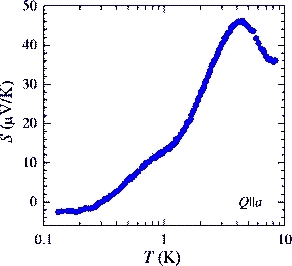| Kondo insulators are strongly correlated electron systems in which the interaction of localized electrons
(mostly from unfilled 4f-shells of rare earth elements) with conduction electrons leads to the opening of a narrow energy gap at the Fermi level.
The microscopic mechanism for this process is far from being well understood.
Our recent investigations have focussed on several systems:
- CeRu4Sn6: The overall behaviour of the physical properties of this cage compound ressemble those of typical Kondo insulators.
In addition, non-Fermi-liquid-like features are observed at low temperatures. In collaboration with Rand Africaans University Johannesburg
and MPI CPfS Dresden.
- CeNiSn (image): The opening of the energy gap is accompanied by a huge maximum in the thermopower below 10 K. In collaboration
with Hiroshima University and MPI CPfS Dresden.
- U2Ru2Sn: The first tetragonal U-based Kondo insulator. In collaboration with Nagoya University,
with Rand Africaans University Johannesburg and MPI CPfS Dresden.
- (Fe,Mn)Si: FeSi is a narrow gap semiconductor with strong hybridisation effects. Substitution of Fe by Mn keeps the B20 crystal
structure unchanged but drives the system towards a metallic state. Right at the insulator to metal transition, transport coefficients
are promising with respect to thermoelectric applications. In addition, non-Fermi liquid features are expected here, similar to those
originated by pressure in the Kondo insulator SmB6. In co-operation with University of Pavia and Slovak Academy of Sciences, Kosice.
|
Giant thermopower of CeNiSn

Fig.1: The thermopower S of CeNiSn displays a large maximum at temperatures below 10 K. This is attributed to a strong
energy dependence of the density of states at the Fermi level, typical of Kondo insulators [from: Paschen et al., Phsy. Rev. B 62 (2000) 14912]
|


